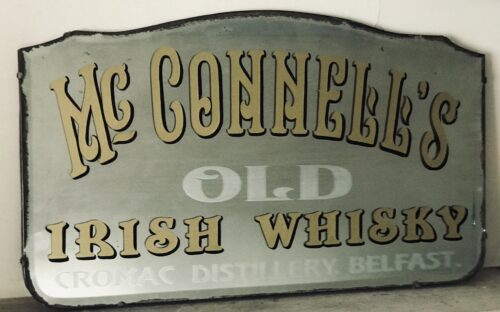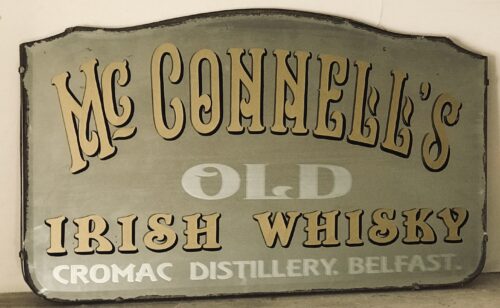Large but gracious Mitchell’s of Belfast Old Irish Whiskey mirror with beautifully bevelled glass bordering.
65cm x 90cm
Once a giant of the distilling business along with Dunvilles,Mitchell’s fall from grace, like so many other superb Irish distilleries was symptomatic of the economic climate and circumstances of the time.
Charles William Mitchell originated from Scotland and took over his fathers distillery in the Campletown area .In the 1860s he moved to Belfast and became manager of Dunvilles Whiskey before establishing his own brand Mitchell & Co tomb St in the late 1860s.A newspaper report in 1895 hailed the virtues of Mitchells Cruiskeen Lawn Whisky,which secured prizes around the world including first place at the New Orleans Exposition.It was a rare Mitchells Cruiskeen Lawn Whiskey mirror that recently commanded £11500 at auction in 2018 following the sale of the contents of an old Donegal public house.
Indeed Mitchell’s were renowned for advertising their products on mirrors, trade cards, minature atlas books and pottery to name just a few. Below is the original mirror that was commissioned for their Tomb Street premises on the launch of their Cruiskeen Lawn Old Irish Whisky, late 1800’s. Two were made for the entrance of their Tomb Street premises. Inscribed is the Cruiskeen Lawn poem, with gold leaf barley with green and red in the Mitchell Crest. Definately the holy grail of all mirrors, a true treasure and still survives today in the heart of Belfast and worth the above mentioned princely sum and now probably more !
Description

Reverse side of print









 Some original and rare Mitchell mirrors are still surviving today and can be found in some pubs in and around Belfast today
Some original and rare Mitchell mirrors are still surviving today and can be found in some pubs in and around Belfast today
 Some other examples of Mitchell Mirrors which were mass produced for advertising their products
Some other examples of Mitchell Mirrors which were mass produced for advertising their products















